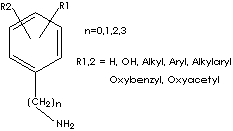PRODUCT IDENTIFICATION

H.S. CODE
TOXICITY
CLASSIFICATION
PHYSICAL AND CHEMICAL PROPERTIES
SOLVENT SOLUBILITY
AUTOIGNITION
NFPA RATINGS
REFRACTIVE INDEX
APPLICATIONS
APPEARANCE
ASSAY
98.0% min
MELTING POINT
141- 145 C
GENERAL DESCRIPTION OF CATECHOLAMINE
Catecholamine: a group of naturally occurring
sympathomimetic amines that have important physiological functions within the
body as neurotransmitters in the central nervous system and hormones in the
blood circulation. Catecholamines are biogenic amines considered as
sympathomimetic drugs; They are characterized by a catechol group [The ortho
(1,2) isomer of dihydroxybenzene] to which is attached an amine group (the
aromatic portion of whose molecule is catechol, and the aliphatic portion an
amine). The most abundant catecholamines in the body are epinephrine
(adrenaline), norepinephrine (noradrenaline) and dopamine. They are derived from
the tyrosine, an amino acid (protein building block) that is the precursor of
norepinephrine. (The prefix nor- describes
normal structure which has no branched chain of carbon atoms. In case of
norepinephrine, it has one less methylene group than its homologue, epinephrine.) Catecholamines belong to a broader class of compounds called
phenethylamines which contain structurally amino acid, phenylalanine and
tyrosine. Phenethylamine is a backbone for the compounds which take roles of
alkaloids as well as hormones and neurotransmitters in nature. Amphetamine is
the substituted phenethylamine by methyl group at alpha position. It is a
synthetic drug used as a diet suppressant and to treat narcolepsy and ADHD
(attention deficit hyperactivity disorder). But amphetamines can produce severe
psychological dependence, including cardiac irregularities and gastric
disturbances. Chronic use often results in extreme exhaustion and malnutrition.
Substituted phenethylamines are:
